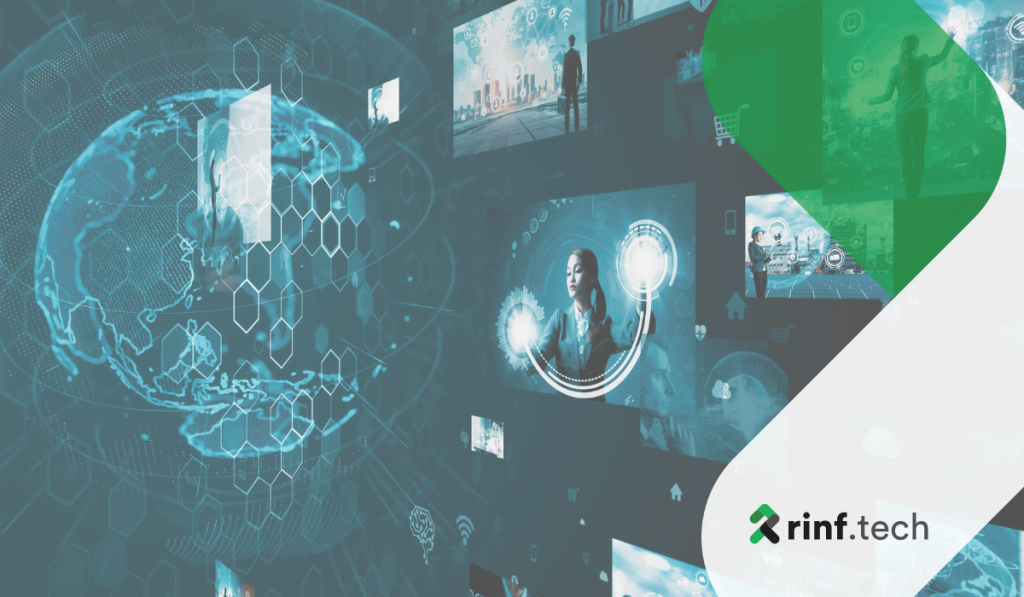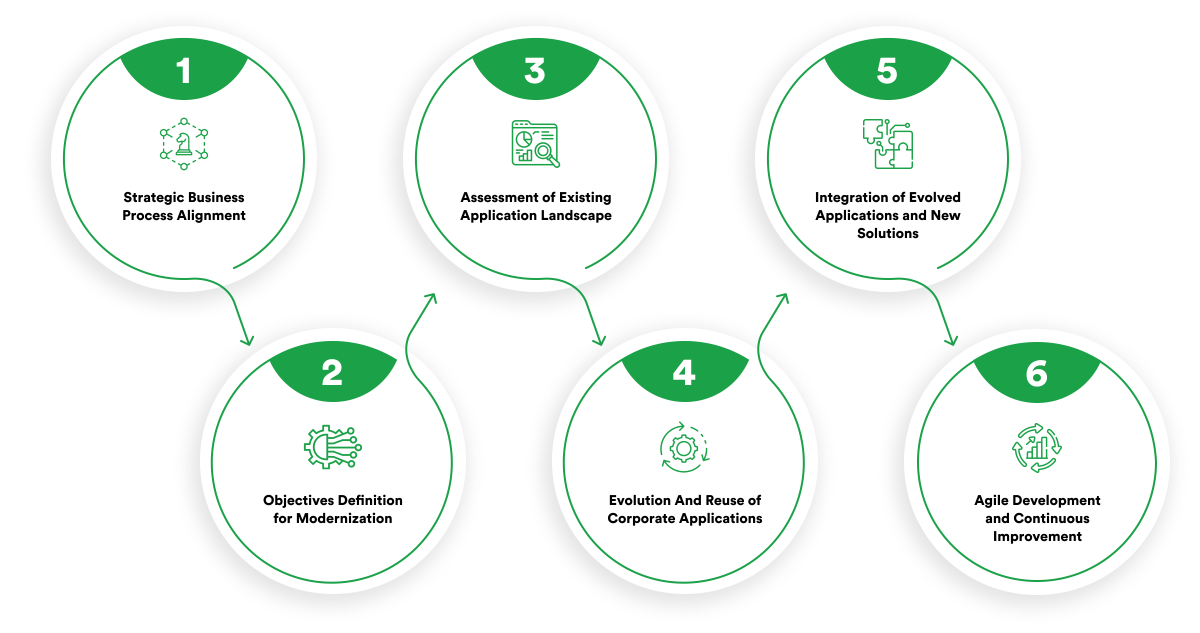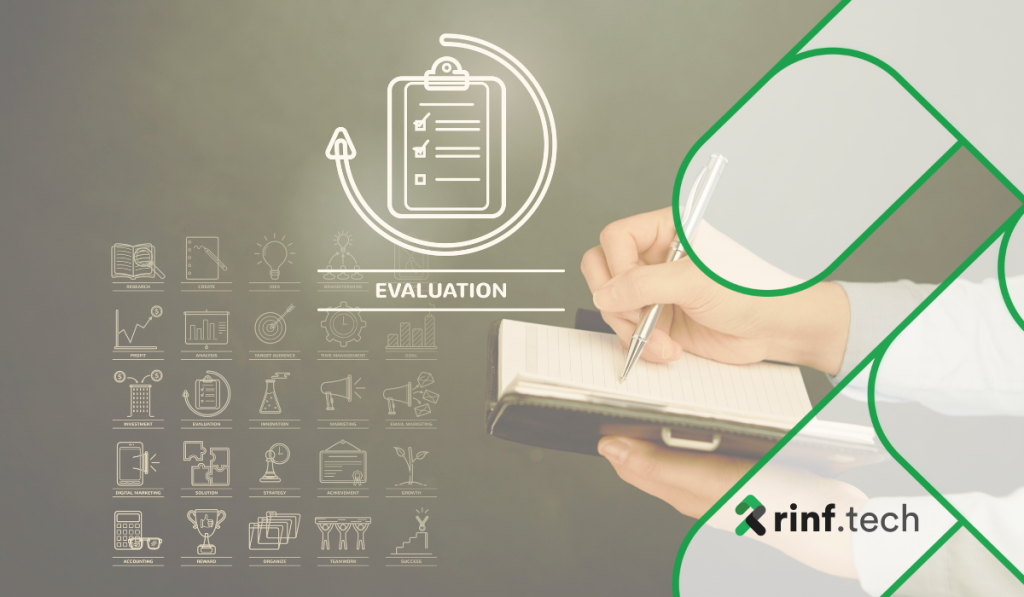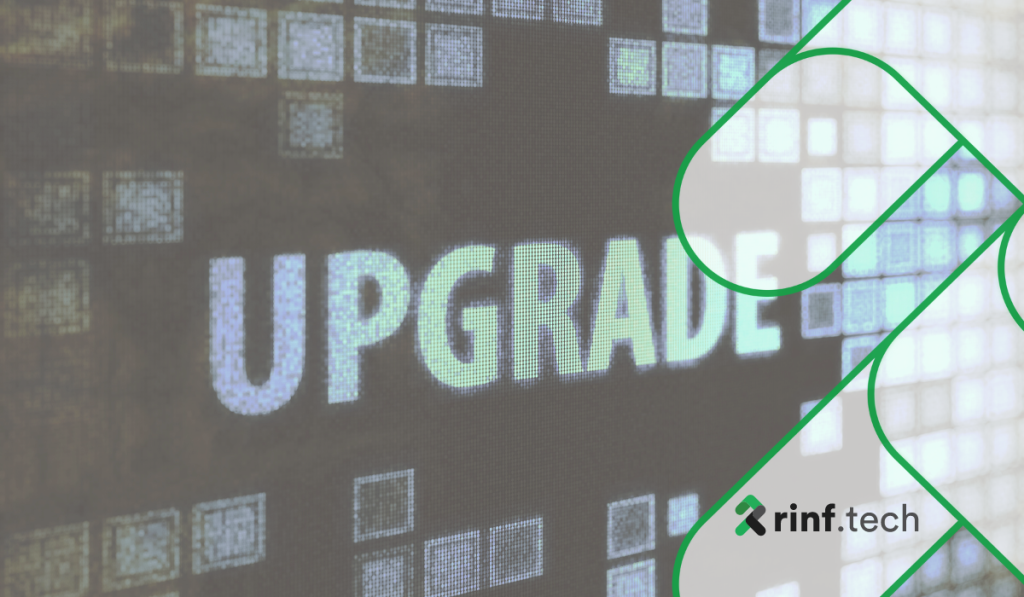The telltale signs that a business should consider digital transformation through application modernization include:
- Fragmented business processes that hinder efficiency and productivity,
- Lack of a seamless and connected digital UX,
- Lack of a strategic alignment between technology initiatives and broader business goals,
- Legacy systems prevent you from becoming more innovative and tech-savvy.
Based on rinf.tech‘s firsthand experience, the path to successful digital transformation through application modernization involves a 6-step approach.
1. Strategic Business Process Alignment
Strategic business process alignment is the foundation of successful digital transformation through application modernization. This practice begins with a detailed analysis of current business processes, focusing on the applications targeted for modernization. A comprehensive evaluation helps identify inefficiencies, bottlenecks, and areas where digital tools can drive improvements.
Next, it is essential to prioritize processes based on their strategic importance and potential impact. This means focusing on applications that directly contribute to key business goals, such as improving customer satisfaction or reducing operational costs. Defining how the modernization of specific applications will contribute to the evolution of the overall business process is critical. For instance, modernized applications can facilitate faster decision-making and more efficient workflows, aligning with the organization’s broader objectives.
Establishing a framework for integrating modernized applications into a cohesive digital ecosystem ensures that these applications work seamlessly together, enhancing overall business performance. This involves setting standards for data interoperability, user interface consistency, and security protocols.
2. Objectives Definition for Digital Transformation Triggered by App Modernization
Clearly defined objectives are essential for guiding app modernization efforts. These objectives should be articulated within the broader digital transformation strategy, reflecting the organization’s vision and priorities. Aligning goals with enhancing business process efficiency, agility, and resilience is vital.
Defining measurable KPIs is crucial for tracking progress. These KPIs might include metrics such as reduced operational costs, increased application uptime, or improved user satisfaction. Establishing a timeline for achieving milestones ensures that modernization efforts stay on track and align with overall business timelines. Developing a management structure to oversee the modernization process and its integration into the digital transformation roadmap is also necessary. Effective management ensures accountability and smooth progress, reducing the risk of project delays and cost overruns.
3. Assessment of Existing Application Landscape
A thorough assessment of the existing app landscape is a foundational step in modernization. This involves evaluating the current state of applications and identifying legacy systems and potential obstacles.
Assessing the compatibility of existing applications with modern technologies and integration requirements helps determine the extent of evolution required. Factors such as scalability, flexibility, and maintainability should be considered. Investigating the reuse potential of specific application components can accelerate modernization and reduce costs.
Developing a phased roadmap for systematic modernization is essential. This roadmap should prioritize critical components and outline the sequence of modernization activities, ensuring a smooth transition and minimizing disruption to business operations.
4. Evolution and Reuse of Corporate Applications
Identifying applications suitable for evolution or reuse is a strategic approach to modernization. This involves selecting applications with robust functionality that can be updated or refactored to align with modern architecture and technology stacks.
Strategizing the phased evolution of existing applications ensures that changes are introduced without disrupting business processes. This may involve reengineering or refactoring specific modules to improve performance, scalability, and maintainability. Assessing the potential for reusing well-functioning parts of applications in new solutions can also accelerate development and reduce costs. Continuous monitoring and feedback mechanisms are vital for iteratively enhancing evolved applications and maximizing reuse, ensuring they meet business needs and user expectations.
5. Integration of Evolved Applications and New Solutions
Effective integration of evolved applications with new solutions is critical for achieving a cohesive digital ecosystem. This involves evaluating the need for new solutions to complement evolved applications or address specific business requirements.
Identifying third-party applications or platforms that align with digital transformation objectives can enhance functionality and efficiency. Assessing the feasibility of integrating newly evolved applications with existing systems and emerging technologies ensures compatibility and smooth data flow. Developing APIs, microservices, or middleware facilitates seamless integration, enabling disparate systems to work harmoniously.
Thorough testing is crucial to validate interoperability and data flow between evolved applications and new solutions. This ensures that integrations work as intended and do not disrupt business operations. Continuous testing and validation help identify and resolve issues promptly, maintaining the integrity and performance of the digital ecosystem.
6. Agile Development and Continuous Improvement
Adopting Agile development methodologies is vital for flexibility and adaptability during application evolution. Agile enables iterative development, allowing for rapid adjustments based on feedback and changing requirements.
Establishing continuous integration and deployment (CI/CD) pipelines facilitates frequent updates and improvements. These pipelines enable iterative releases, ensuring that new features and enhancements are deployed quickly and efficiently. Breaking modernization projects into manageable sprints focuses on specific components or functionalities, ensuring steady progress and manageable workloads.
Regularly releasing updates, improvements, or newly integrated features based on user feedback helps prioritize enhancements that deliver the most value. Monitoring application performance and user satisfaction in real-time allows for continuous improvement, ensuring that applications meet business needs and user expectations throughout the digital transformation journey.




